How to harvest peaches? It’s a question that pops up every summer when those juicy, sun-kissed fruits start to ripen on the branches. But picking peaches isn’t just about grabbing the first one you see – there’s a whole art to it, from selecting the right variety to knowing when they’re perfectly ripe.
This guide will walk you through every step, from choosing the ideal peach tree to storing your harvest for maximum enjoyment.
We’ll explore the secrets of recognizing ripeness, mastering harvesting techniques, and preserving your peaches for a taste of summer all year round. Get ready to dive into the world of peach perfection!
Peach Tree Selection and Preparation
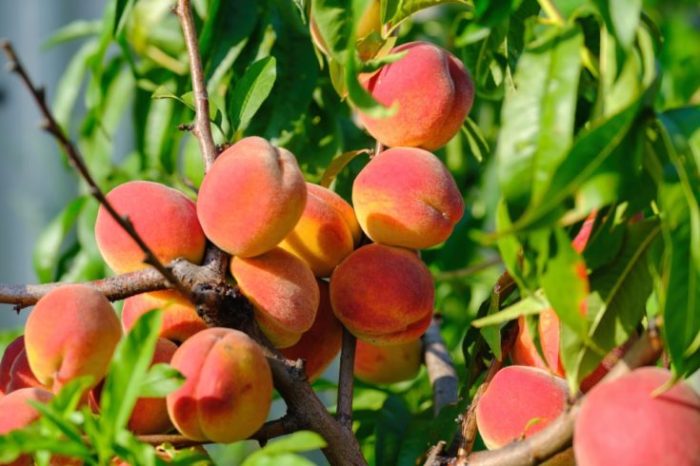
Selecting the right peach variety and preparing the planting site are crucial steps for successful peach tree cultivation. Choosing a variety well-suited to your region’s climate and soil conditions ensures optimal growth and fruit production.
Peach Varieties
Peach varieties differ in their ripening time, flavor, size, and other characteristics. Consider these factors when choosing a variety for your garden:
- Ripening Time:Early-season varieties ripen in June or July, while late-season varieties ripen in August or September. Choose a variety that aligns with your region’s growing season.
- Flavor:Peach varieties offer a range of flavors, from sweet to tart. Consider your personal preferences and the intended use of the peaches (e.g., eating fresh, canning, baking).
- Size:Peach varieties vary in fruit size, from small to large. Consider your desired size and how you plan to use the peaches.
Here are some popular peach varieties and their characteristics:
| Variety | Ripening Time | Flavor | Size | Other Characteristics |
|---|---|---|---|---|
| Redhaven | Mid-season | Sweet | Medium | Good for fresh eating and canning |
| Elberta | Late-season | Sweet | Large | Excellent for fresh eating and canning |
| Contender | Early-season | Sweet | Medium | Disease-resistant, good for fresh eating |
| Sunhaven | Mid-season | Sweet | Medium | Good for fresh eating and canning |
| Georgia Belle | Late-season | Sweet | Large | Excellent for fresh eating and canning |
Soil Conditions
Peach trees thrive in well-drained, sandy loam soil with a pH between 6.0 and 6.5. Avoid planting peach trees in areas with poor drainage, as this can lead to root rot.
Harvesting peaches is a delightful summer activity, but it can be frustrating if those pesky grasshoppers are munching on your precious fruit. To keep those critters at bay, consider planting some grasshopper repellent plants around your peach trees. Marigolds, lavender, and rosemary are known to deter these insects, creating a natural barrier that protects your peaches from damage.
With a little planning and the right companion plants, you can enjoy a bountiful harvest of delicious, grasshopper-free peaches.
Planting Site Preparation, How to harvest peaches
1. Choose a sunny location
Peach trees need at least 6 hours of direct sunlight per day.
2. Prepare the soil
Amend the soil with compost or manure to improve drainage and fertility.
3. Remove weeds and debris
Clear the planting area of any weeds or debris that could compete with the peach tree for nutrients and water.
Planting Peach Trees
1. Dig a hole
Dig a hole twice as wide and as deep as the root ball.
2. Place the tree in the hole
Ensure the graft union (the point where the scion is grafted onto the rootstock) is above the soil line.
3. Backfill the hole
Fill the hole with soil, gently tamping it down to eliminate air pockets.
Harvesting peaches is all about timing. You want to pick them when they’re ripe but still firm, so they don’t get bruised. Just like you need to pay attention to the timing of your lawn care in the summer, summer lawn care is all about keeping things healthy and thriving.
Once you’ve got your peaches, you can enjoy them fresh or use them to make delicious jams and pies. And just like your lawn, the best way to enjoy your peach harvest is with a little care and attention.
4. Water thoroughly
Water the tree deeply to settle the soil around the roots.
5. Mulch
Apply a 2-4 inch layer of organic mulch around the base of the tree to help retain moisture and suppress weeds.
Spacing
Space peach trees 15-20 feet apart to allow for adequate airflow and sunlight penetration.
Recognizing Ripeness
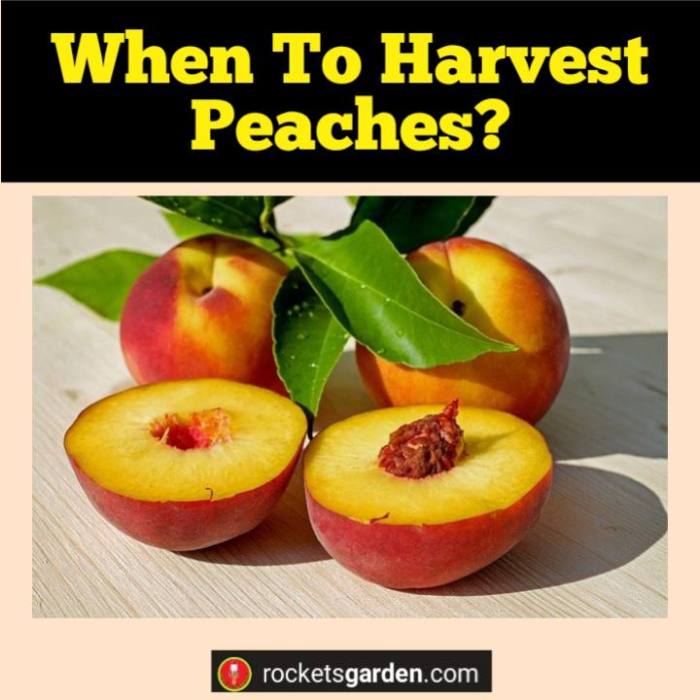
Knowing when to pick your peaches is crucial for enjoying their peak flavor and texture. The sweet spot for harvesting is when they’re perfectly ripe, and that means paying attention to visual cues and understanding the difference between tree-ripened and store-bought peaches.
Visual Cues of Ripeness
Visual cues provide a good indication of ripeness. Here’s what to look for:
- Color Change:As peaches ripen, their skin color deepens and becomes more vibrant. The color change varies depending on the peach variety, but generally, a deeper, more intense color indicates ripeness. For example, a white peach will transition from pale green to a creamy white, while a yellow peach will turn from pale green to a golden yellow.
- Firmness:A ripe peach will be slightly soft to the touch, but not mushy. When you gently press on the side of the peach, it should give slightly, but not sink in. Avoid peaches that are hard or overly soft, as these may not be at their peak flavor.
- Scent:Ripe peaches have a sweet, fruity aroma. If you can smell the sweetness of the peach without even cutting it open, it’s likely ripe.
Importance of Picking at the Right Time
Picking peaches at the right time is essential for maximizing flavor and texture.
Peaches that are picked too early will be firm, tart, and lack sweetness.
Peaches that are picked too late will be overly soft, mushy, and may have a fermented flavor.
Tree-Ripened vs. Store-Bought Peaches
There’s a distinct difference between tree-ripened peaches and store-bought peaches.
- Tree-ripened peachesare picked at their peak ripeness, directly from the tree. They have the most intense flavor and aroma, as they’ve had time to develop fully on the branch.
- Store-bought peachesare often picked before they are fully ripe to ensure they can withstand transportation and storage. They may be less flavorful and have a shorter shelf life compared to tree-ripened peaches.
Harvesting Techniques
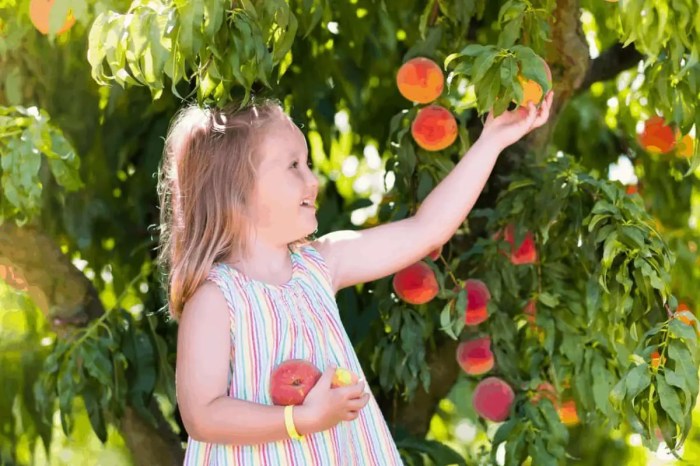
Picking peaches at the right time is crucial to ensure the best flavor and quality. Harvesting too early will result in a tart, under-ripe peach, while picking too late may lead to a mushy, overripe fruit. Once you’ve determined the ripeness of your peaches, it’s time to harvest them.
Picking Peaches
- Gentle Handling:Peaches are delicate fruits, and rough handling can easily bruise them. When picking, grasp the peach firmly but gently, near the stem. Avoid squeezing or twisting the fruit.
- Using the Right Technique:To detach the peach from the branch, gently twist it back and forth while pulling upward. If the peach doesn’t come off easily, try using a pair of pruning shears to cut the stem close to the fruit.
- Inspecting for Damage:Before placing the peach in your basket or container, inspect it for any signs of damage, such as bruises, cuts, or insect bites. Discard any damaged peaches to prevent them from spoiling the rest of your harvest.
Using Tools for Harvesting
- Ladders:For peaches growing high on the tree, a sturdy ladder is essential. Make sure the ladder is placed on a stable surface and extend it high enough to reach the fruit without overreaching. Always follow ladder safety guidelines, and never climb a ladder alone.
- Pruning Shears:Pruning shears are useful for cutting the stems of peaches that are difficult to twist off. Use sharp shears to make a clean cut close to the fruit, avoiding any damage to the peach.
- Picking Baskets:Picking baskets or containers with handles are ideal for carrying peaches as you harvest. Choose a basket with a sturdy bottom and a comfortable handle to prevent dropping the fruit.
Storing and Preserving Peaches: How To Harvest Peaches
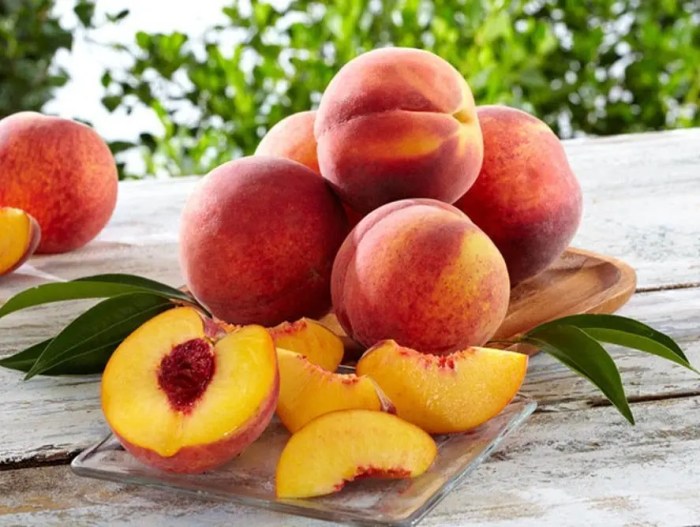
You’ve harvested your delicious peaches, but now what? Storing and preserving peaches properly is essential to enjoy their sweetness and juiciness for as long as possible. Here’s a guide to help you make the most of your peach harvest.
Storing Peaches at Room Temperature and in the Refrigerator
Storing peaches at room temperature allows them to ripen further and develop their full flavor. However, this method is only suitable for peaches that are already ripe or close to ripening. To store peaches at room temperature, place them in a single layer in a bowl or basket, ensuring they are not touching each other.
Avoid storing them in direct sunlight or near heat sources.For longer storage, refrigerating peaches is the best option. Place them in a single layer in a plastic bag or container lined with paper towels to absorb excess moisture. Refrigerated peaches can last for up to a week.
Freezing Peaches for Long-Term Storage
Freezing peaches is an excellent way to preserve them for several months. To freeze peaches, wash, peel, and slice them. Blanching the peaches for 30 seconds before freezing helps maintain their color and texture. Spread the sliced peaches on a baking sheet lined with parchment paper and freeze for 1-2 hours.
Once frozen, transfer the peaches to freezer-safe bags or containers. Frozen peaches can be stored for up to 12 months.
Preserving Peaches: Canning, Jam-Making, and Drying
Preserving peaches allows you to enjoy their flavor throughout the year. Here are some popular methods:
Canning
Canning peaches involves sealing them in jars with a hot sugar syrup or water bath. This method requires careful sterilization and processing to ensure the peaches are safely preserved. Canning peaches allows you to enjoy them in their natural form or use them in various recipes.
Jam-Making
Jam-making is a popular way to preserve peaches and create a sweet and spreadable treat. Peaches are cooked with sugar and pectin to create a thick and flavorful jam. Jam can be stored in sterilized jars for several months.
Drying
Drying peaches is a simple and natural method of preservation. Peaches are sliced and dried in a dehydrator, oven, or even in the sun. Dried peaches are a nutritious snack and can be used in various recipes.
Comparison of Storage and Preservation Methods
| Method | Pros | Cons |
|---|---|---|
| Room Temperature Storage | Simple, allows for further ripening | Short storage time, susceptible to spoilage |
| Refrigerator Storage | Longer storage time, preserves freshness | May slow down ripening process |
| Freezing | Long storage time, preserves flavor and texture | Requires blanching, takes up freezer space |
| Canning | Long shelf life, preserves natural flavor | Requires sterilization and processing, can be time-consuming |
| Jam-Making | Creates a versatile spread, long shelf life | Requires sugar and pectin, can be messy |
| Drying | Natural method, creates a nutritious snack | Can be time-consuming, requires specific equipment |
Troubleshooting and Common Issues
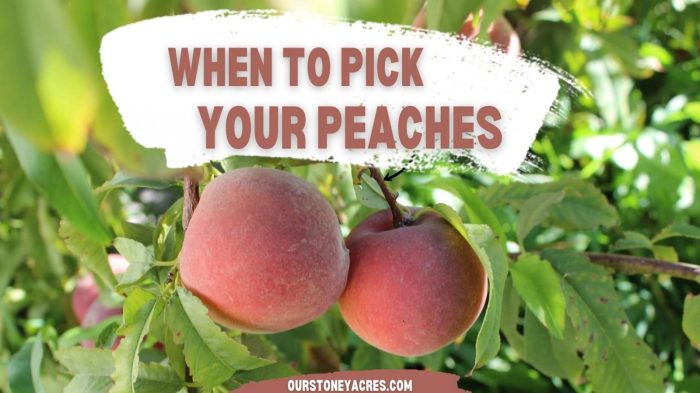
While peach trees are generally resilient, they can be susceptible to various issues that can affect their health and fruit production. Understanding these problems and implementing preventative measures can significantly improve your harvest.
Pests and Diseases
Pests and diseases can cause significant damage to peach trees, leading to reduced fruit yield and quality.
- Peach Leaf Curl:This fungal disease causes leaves to become distorted and curled, leading to reduced fruit production. It is most common in wet, humid conditions.
- Brown Rot:This fungal disease can cause fruit rot, blossom blight, and twig dieback. It is most common in warm, humid conditions.
- Peach Borer:This insect pest burrows into the trunk of the tree, causing damage that can lead to tree decline and death.
- Oriental Fruit Moth:This insect pest attacks fruit, causing damage that can lead to premature fruit drop and reduced quality.
Preventing and Managing Pests and Diseases
- Pruning:Regular pruning helps improve air circulation and sunlight penetration, which can help prevent the development of diseases.
- Sanitation:Remove and destroy diseased or infested branches and fruit to prevent the spread of pests and diseases.
- Fungicides:Apply fungicides to prevent and control fungal diseases.
- Insecticides:Use insecticides to control insect pests.
Environmental Factors
Environmental factors can also affect peach tree growth and fruit production.
- Temperature:Peach trees are sensitive to extreme temperatures. Frost damage can occur during the spring, and high temperatures during the summer can lead to fruit drop.
- Water:Peach trees require adequate water, but they are also susceptible to root rot if they are overwatered.
- Soil:Peach trees prefer well-drained soil that is rich in organic matter. Poor soil drainage can lead to root problems.
Managing Environmental Factors
- Frost Protection:Use frost blankets or irrigation to protect trees from frost damage.
- Irrigation:Water trees regularly, especially during dry periods.
- Soil Amendments:Improve soil drainage and fertility by adding organic matter.
Dealing with Damaged or Underripe Peaches
- Damaged Peaches:Damaged peaches are often susceptible to disease and should be removed from the tree and discarded.
- Underripe Peaches:Underripe peaches will not ripen after they are picked. If you pick peaches that are underripe, they will likely be tart and have a poor flavor.
Outcome Summary
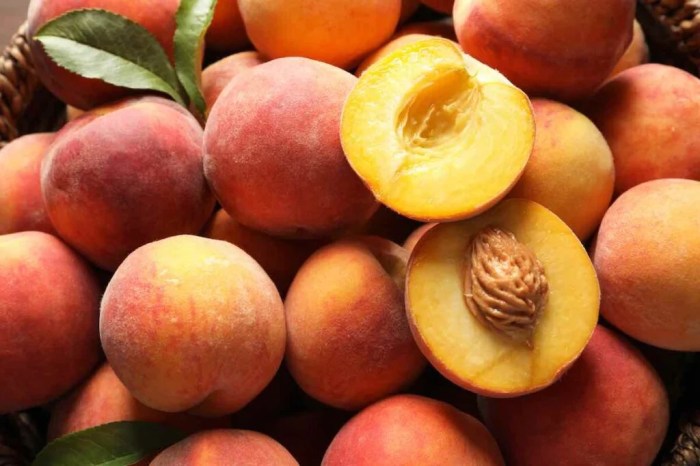
Harvesting peaches is a rewarding experience, allowing you to enjoy the fruits of your labor (quite literally!). With the right knowledge and a little patience, you can pick the sweetest, most delicious peaches imaginable. So, grab your basket, put on your gardening gloves, and get ready to embrace the bounty of the peach season!